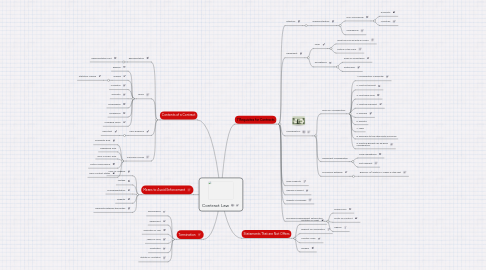
1. Contents of a Contract
1.1. Representation
1.1.1. Representation Test
1.2. Terms
1.2.1. Express
1.2.2. Implied
1.2.2.1. Statutory Implied
1.2.3. Condition
1.2.4. Warranty
1.2.5. Meaningless
1.2.6. Ambiguous
1.2.7. Changing Terms
1.3. Parol Evidence
1.3.1. Reluctant
1.4. Exclusion Clause
1.4.1. Ambiguity Rule
1.4.2. Negligence Rule
1.4.3. “Four Corners” Rule
1.4.4. Notice Given before
1.4.5. Main Contract states
2. Means to Avoid Enforcement
2.1. Void Vs Voidable
2.2. Mistake
2.3. Misrepresentation
2.4. Illegality
2.5. Inequality between the parties
3. Termination
3.1. Performance
3.2. Agreement
3.3. Operation of Law
3.4. Lapse of Time
3.5. Frustration
3.6. Statute of Limitation
4. 7 Requisites for Contracts
4.1. Intention
4.1.1. Implied Intention
4.1.1.1. Non-Commercial
4.1.1.1.1. Domestic
4.1.1.1.2. Voluntary
4.1.1.2. Commerical
4.2. Agreement
4.2.1. Offer
4.2.1.1. What can you do with an Offer?
4.2.1.2. Notice of the Offer
4.2.2. Acceptance
4.2.2.1. Rules of Acceptance
4.2.2.2. Postal Rule
4.3. Consideration
4.3.1. Rules for Consideration
4.3.1.1. 1. Consideration is essential
4.3.1.2. 2. Must not be past
4.3.1.3. 3. Must have value
4.3.1.4. 4. Must be sufficient
4.3.1.5. 5. Possible
4.3.1.6. 6. Definite
4.3.1.7. 7. Legal
4.3.1.8. 8. Referable to the other party's promise
4.3.1.9. 9. Practical Benefit can be good consideration.
4.3.2. Insufficient Consideration
4.3.2.1. Moral Obligations
4.3.2.2. Part Payment
4.3.3. Promissory Estoppel
4.3.3.1. Brennan J's (Waltons V Maher 6 Step Test
4.4. Legal Capacity
4.5. Genuine Consent
4.6. Legality of Purposes
4.7. Procedural Requirement Satisfaction.
4.7.1. Proper Form
4.7.2. Privity of Contract
4.7.3. Agency
